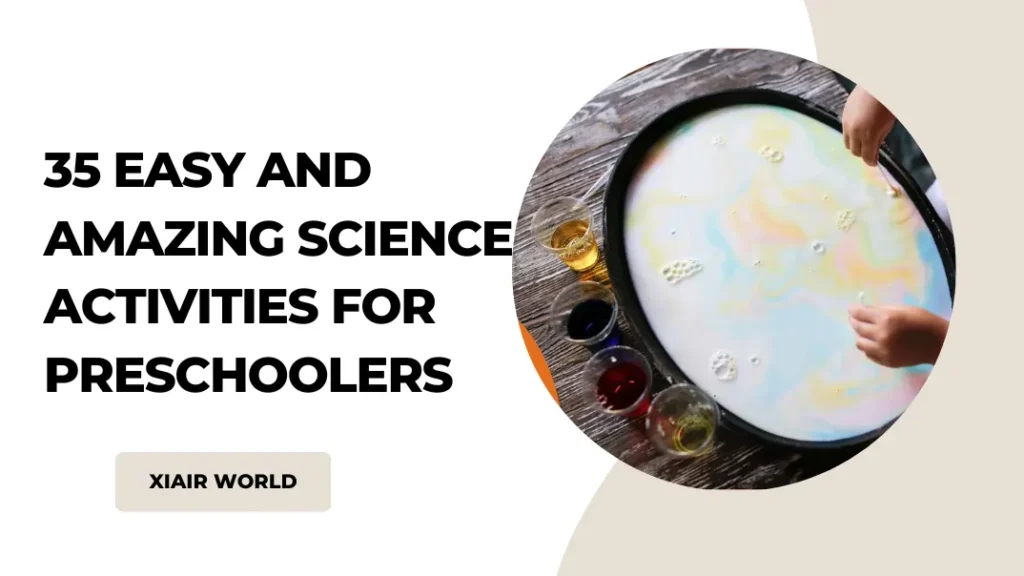Science is all around us, and introducing it to preschoolers through engaging activities can spark their curiosity and foster a lifelong love for learning. But what are the best ways to introduce science activities for preschoolers? Let’s explore the importance of science activities for young children, the key concepts they need to understand, and how to prepare for fun, enriching science experiments in your classroom.
Science activities for preschoolers are crucial because they stimulate curiosity, promote literacy, and encourage cooperative learning. Additionally, these activities help children develop critical thinking and creativity, essential skills in today’s world.
By making science fun and interactive, we can help young minds become more curious about the world around them.
Importance of Science Activities for Preschoolers
Science activities for preschool are vital for children’s early development because they provide opportunities to explore and understand their environment through hands-on experiments. These activities engage different areas of a child’s brain, fostering growth in literacy, creativity, and problem-solving skills. Here’s why they are essential:
- Stimulate Curiosity: Science activities for preschoolers tap into their natural sense of wonder. Preschoolers ask countless questions, and science allows them to explore answers through discovery. For preschoolers, open-ended science activities encourage children to keep experimenting.
- Develop Literacy: Many science activities for preschoolers involve reading instructions, describing observations, and discussing results, which helps improve vocabulary and language skills. For example, labeling objects in fall science activities for preschoolers or spring science activities for preschoolers helps expand their vocabulary.
- Promote Cooperative Learning: Group small group science activities for preschoolers require teamwork. Children learn to communicate, share, and cooperate as they solve problems, building social and communication skills.
- Encourage Creativity: Creative science activities for preschoolers help children think outside the box. They experiment with different outcomes, which develops their innovative thinking skills. Whether outdoor science activities for preschoolers, like building a weather station, or winter activities for preschoolers for science, such as observing frost patterns, they learn to think creatively.
- Develop Critical Thinking: Best science activities for preschoolers foster critical thinking by introducing children to the scientific method. They learn to observe, form hypotheses, and experimentally test their ideas. Even simple experiments like a science sensory activity for preschoolers, such as creating sensory bottles, can teach kids to make connections between cause and effect.
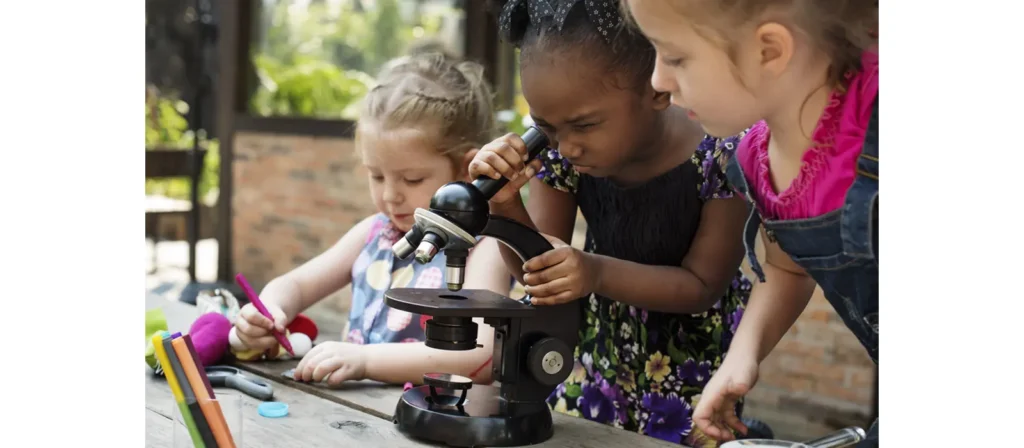
What Science Concepts Should Preschoolers Understand?
When teaching science activities for preschoolers, it’s essential to introduce basic science concepts in a way they can grasp. These ideas build a foundation for future learning, and children can better understand the world around them when they interact with these concepts during play. Here are key concepts to focus on:
- Cause and Effect: One of the most fundamental concepts in science for preschoolers activities is cause and effect. Simple experiments like combining baking soda and vinegar show children how actions produce reactions. Montessori science activities for preschoolers often emphasize this hands-on, discovery-based learning.
- Observation Skills: Encourage children to observe their surroundings. These activities enhance their attention to detail, whether spring science activities for preschoolers, like watching plants grow, or fall science activities for preschoolers, like observing leaves change color.
- Basic Scientific Vocabulary: Introduce simple terms like “sink and float,” “solid and liquid,” or “hot and cold” during experiments. Activities like indoor science activities for preschoolers can focus on these vocabulary lessons while they play and learn.
- Life Cycles: Teach children about the life cycles of plants, animals, or insects. For instance, in summer science activities for preschoolers, you can plant seeds and watch them grow, explaining how plants develop from seeds into mature plants.
- Simple Physics Concepts: Activities involving ramps, pulleys, or magnets introduce children to basic physics principles like gravity and force. Science and sensory activities for preschoolers can demonstrate these concepts through tactile play.
- Exploring the Five Senses: Engaging children’s senses is important to learning science. Science sensory activities for preschoolers that involve smell, touch, and sound help them explore the world more holistically.
By using lesson plans for science activities for preschoolers that focus on these concepts, teachers can introduce children to a world of discovery that is easy to understand and fun to explore.

How to Prepare for Preschool Science Activities?
Preparation is crucial to make the most of science activities for preschoolers. Creating a structured and engaging learning environment ensures that children are safe and supported while they explore new scientific concepts. Here are some tips to help you prepare for science learning activities for preschoolers:
- Create a Learning Environment: Designate a space in your classroom where children can experiment and explore safely. Use easily accessible materials, and make the environment visually appealing with displays that spark interest. For example, a science center activity for preschoolers can be set up where they can interact with materials like magnifying glasses, scales, and measuring cups.
- Incorporate Learning Topics: Align science activities with broader classroom themes. For example, if your topic is animals, try a related activity science for preschool, such as creating animal habitats or learning about life cycles through small group activities.
- Choose Age-Appropriate Experiments: Pick activities suitable for young learners, ensuring they are fun and safe. Outdoor science activities for preschoolers might include exploring nature trails, while indoor science activities for preschoolers can focus on sensory-based experiments like exploring different textures.
- Follow a Step-by-Step Process: Preschoolers need clear, simple instructions. Break down each step of the activity to ensure they understand. For example, for math science activities for preschoolers, you can have them measure ingredients for a baking soda volcano or count objects during an experiment.
- Select the Right Materials: Gather non-toxic and child-friendly materials for every experiment. Everyday objects like water, sand, and small household items are perfect for creating safe and engaging science for preschool activities.
- Safety First: Always supervise children closely during experiments. Ensure you use child-safe materials and explain any potential risks before starting the activity.
By preparing thoroughly and choosing the right experiments, you can create a dynamic learning experience for children through open-ended science activities for preschoolers.

Science Activities for Preschoolers
Now that you’re ready let’s dive into some of the best science activities for preschoolers. Each experiment is easy to set up and uses materials you probably already have. There’s something for every season, from fall science activities for preschoolers to fun winter experiments.
1. Baking Soda and Vinegar Volcano
Materials: Baking soda, vinegar, dish soap, food coloring, small container, tray.
This classic experiment introduces children to chemical reactions. Combining baking soda (a base) and vinegar (an acid) creates a bubbly eruption miming a volcano. Adding dish soap helps the bubbles last longer, while food coloring makes the “lava” more fun and visual. This science activity for preschool is great for showing cause and effect and introducing the concept of acids and bases.
2. Ice Melting Race
Materials: Ice cubes, salt, food coloring, water.
In this experiment, children learn about the effects of temperature and the properties of salt. Have children race to melt ice cubes using salt and water. Adding food coloring lets them visually track how fast the ice is melting. This is one of the easiest winter activities for preschoolers for science, teaching them about freezing and melting points.
3. Sink or Float
Materials: Various small objects (rocks, sponges, plastic toys), water containers.
Preschoolers can explore the concepts of density and buoyancy through this fun water-based activity. Let them guess whether different objects will sink or float and then test their predictions. This science sensory activity for preschoolers engages their tactile senses and helps develop observation skills.
4. Color Mixing with Water
Materials: Water, food coloring, clear cups.
This easy science activity for preschoolers teaches them about primary and secondary colors. Fill cups with water and different food coloring, and let children mix the colors in separate containers. Watching the colors change is a fun and hands-on way for preschoolers to learn about color theory and chemical reactions.
5. Planting Seeds
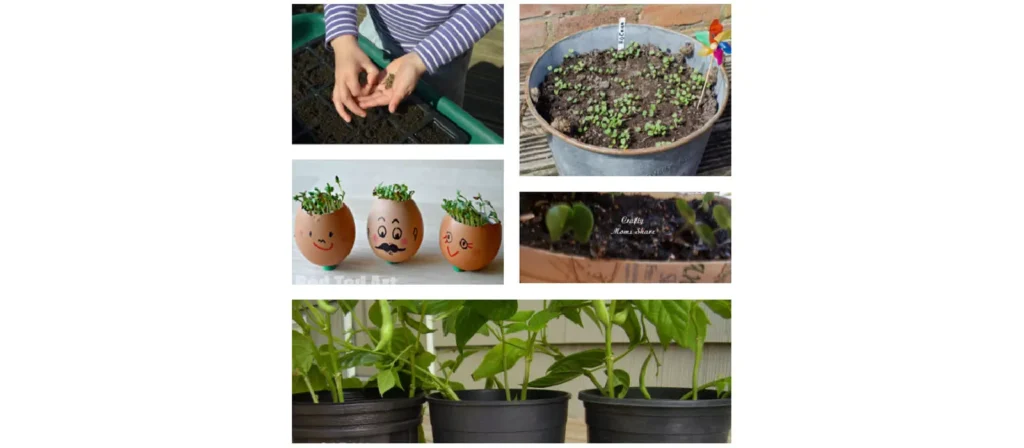
Materials: Seeds, soil, small pots, water.
This spring science activity for preschoolers introduces children to plant biology and the life cycle of plants. By planting and watching seeds grow, preschoolers learn what plants need to thrive—sunlight, water, and soil. They’ll be able to observe daily changes and understand the basics of plant growth.
6. Shadow Play
Materials: Flashlight, various objects, wall or screen.
In this science center activity for preschoolers, children learn about light and shadows by using a flashlight to create shadows of various objects. They can move the objects closer or farther from the light to see how the size of the shadow changes, introducing them to the concepts of light and space.
7. Magnet Fun
Materials: Magnets and various small objects (paper clips, spoons, coins).
This experiment introduces children to the concept of magnetism. Let them explore which objects are attracted to magnets and which are not. This is one of the most interactive small-group science activities for preschoolers, as children can take turns testing different objects and discovering how magnets work.
8. Rainbow in a Jar
Materials: Water, sugar, food coloring, clear jars.
Create a rainbow effect in a jar by layering colored water with different sugar concentrations. This experiment teaches children about density and how different substances interact. This science activity for preschool is both visually stunning and informative.
9. Balloon Rocket
Materials: Balloons, string, tape, straw.
This experiment teaches preschoolers about propulsion and Newton’s Third Law of Motion. Attach a balloon to a straw threaded through a string, tape it down, and let it go. As the air escapes, the balloon zooms forward, demonstrating action and reaction.
10. Butterfly Life Cycle Craft
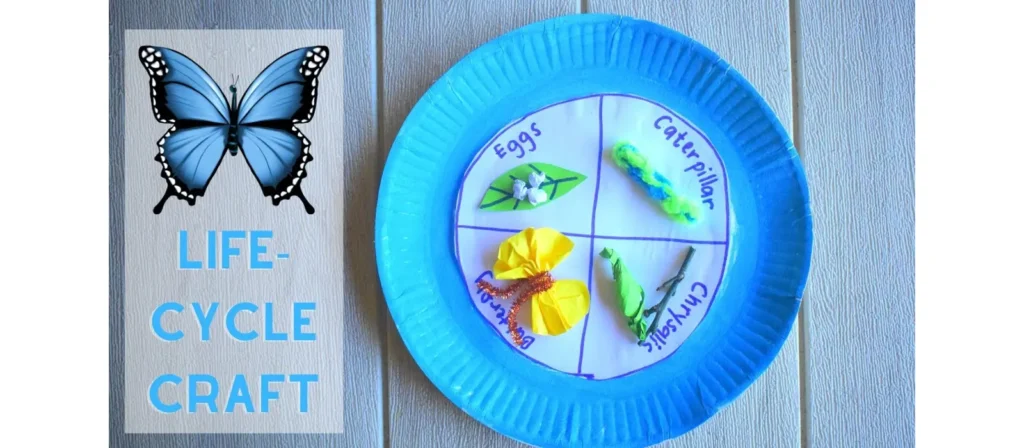
Materials: Paper, glue, scissors, coloring materials.
In this activity, children create the life cycle of a butterfly from egg to caterpillar, chrysalis, and finally, a butterfly using craft materials. This hands-on science activity for preschoolers teaches them about biology and life cycles in a creative way. It helps them understand how living organisms grow and change. They also develop fine motor skills while learning scientific concepts as they cut and glue.
11. Make a Tornado in a Bottle
Materials: Two plastic bottles, water, duct tape.
This indoor science activity for preschoolers shows how tornadoes form. Fill one bottle with water, attach another bottle upside down to the top using duct tape, and swirl the water to create a vortex. Preschoolers learn about the forces that develop tornadoes, introducing them to the concepts of vortexes and air pressure dynamics. It’s a simple, visual way to explore weather patterns, making it a great choice for fall science activities for preschoolers.
12. Egg Drop Challenge
Materials: Eggs, various cushioning materials (cotton, bubble wrap, foam).
In this open-ended science activity for preschoolers, children create a protective layer around an egg to prevent it from breaking when dropped. This activity encourages them to think like engineers, using trial and error to design a protective structure. It teaches physics concepts (gravity, impact, and force) and builds problem-solving skills as children experiment with different materials.
13. Balloon Static Electricity
Materials: Balloons, small paper pieces.
This fun, interactive science sensory activity for preschoolers introduces them to static electricity. Rub a balloon or a sweater on your head, bring it close to small paper pieces, and watch the pieces stick. It’s a simple and effective way to explain how static electricity works by showing children how different materials can create electrical charges when rubbed together.
14. Water Xylophone
Materials: Glass jars, water, food coloring, spoon.
By filling glass jars with different amounts of water and letting children tap them with a spoon, this preschool science activity introduces them to sound waves and vibrations. Each jar produces a different pitch based on the amount of water inside. It combines science and music well, making it ideal for creative, sensory-rich learning.
15. Leaf Rubbings
Materials: Paper, crayons, leaves.
Children can explore nature with this fall science activity for preschoolers by creating leaf rubbings. Place a leaf under a sheet of paper and rub a crayon over it to reveal the texture and shape of the leaf. This activity teaches preschoolers about different plant structures and encourages them to observe their natural environment closely.
16. Cloud in a Jar

Materials: Glass jar, ice cubes, warm water, hairspray.
In this winter science activity for preschoolers, you simulate the formation of clouds. Fill a jar with warm water, spray hairspray, and place ice cubes on top. As the warm air meets the cool air from the ice cubes, condensation forms, creating a cloud inside the jar. This teaches children about weather systems and how clouds form, making it an engaging weather experiment.
17. Walking Water
Materials: Water, food coloring, paper towels, clear cups.
Place colored water in two cups with an empty cup in between. Fold a paper towel to dip one end into the colored water and the other into the empty cup. Over time, the water “walks” through the paper towel into the empty cup. This science learning activity for preschoolers introduces capillary action and how water moves through porous materials.
18. Magic Milk
Materials: Milk, food coloring, dish soap, cotton swabs, plate.
Pour milk onto a plate and drop in different colors of food coloring. Dip a cotton swab in dish soap and touch it to the milk. The colors will swirl and spread as the soap breaks the surface tension of the milk. This experiment teaches preschoolers about chemical reactions and the properties of liquids, making it a great science and sensory activity for preschoolers.
19. Lava Lamp Experiment
Materials: Water, vegetable oil, food coloring, Alka-Seltzer tablets, bottle.
Create a lava lamp effect by layering water and vegetable oil in a bottle and adding food coloring. Drop in an Alka-Seltzer tablet and watch as bubbles rise and fall. This creative science activity for preschoolers teaches about density and introduces them to the concept of immiscible liquids (liquids that don’t mix), making it a colorful and exciting learning experience.
20. Growing a Bean in a Bag

Materials: Plastic bag, damp paper towel, bean seeds, tape.
Place a damp paper towel and a bean seed in a clear plastic bag and tape it to a window. Over time, the seed will sprout, and children can observe the stages of plant growth. This is an ideal spring science activity for preschoolers to introduce them to the life cycle of plants and the concept of germination.
21. Fizzy Lemon Volcano
Materials: Lemon, baking soda, dish soap, food coloring, spoon.
Cut a lemon in half, sprinkle baking soda on the cut surface, and watch it fizz as the acid in the lemon reacts with the baking soda. Add dish soap for extra bubbles and food coloring for a visual effect. This fun science activity for preschoolers teaches easily and excitingly about acid-base reactions.
22. Paper Towel Chromatography
Materials: Markers, water, paper towels, small cups.
Draw a thick line on a paper towel with markers and dip the edge in water. Watch as the water moves up the towel, separating the colors. This easy science activity for preschoolers introduces children to chromatography and helps them understand how different pigments mix to create colors.
23. Balloon-Powered Car
Materials: Balloon, plastic bottle, straws, tape, bottle caps.
Build a simple car using a plastic bottle for the body, bottle caps for the wheels, and a balloon for propulsion. Blow up the balloon, tape it to the car, and let it go. This outdoor science activity for preschoolers teaches about propulsion, air pressure, and engineering principles as children see their balloon-powered car zoom forward.
24. Egg in a Bottle
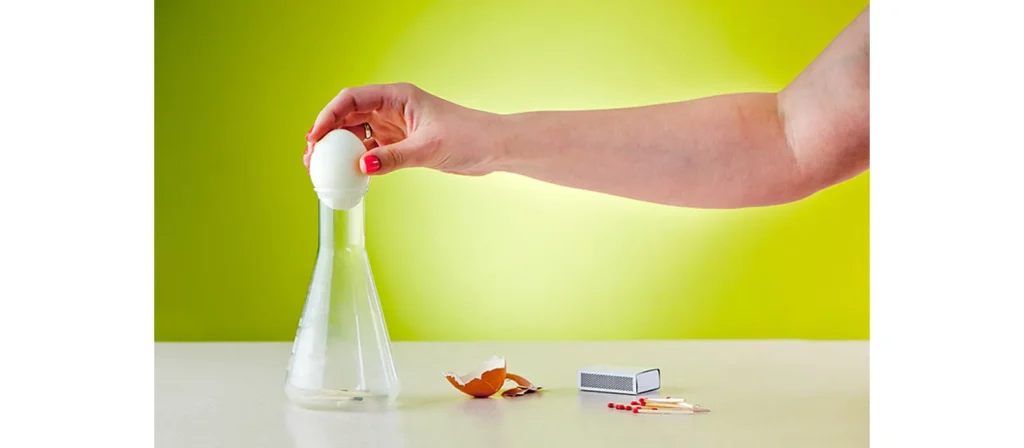
Materials: Hard-boiled egg, glass bottle, match, or small burning paper.
Place a lit match or burning paper inside a glass bottle and quickly place a hard-boiled egg on the bottle’s opening. As the air inside cools and creates a vacuum, the egg is sucked into the bottle. This science center activity for preschoolers teaches children about air pressure and the effects of heat.
25. Floating Egg Experiment
Materials: Water, salt, egg, clear cup.
In this simple yet educational experiment, children learn about density. Start with a cup of water where the egg sinks. Then, slowly add salt until the egg floats. This activity science for preschool demonstrates how adding salt changes the density of water, allowing objects to float or sink.
26. Sticky Ice
Materials: Ice cubes, string, salt.
Place a string on an ice cube and sprinkle salt over the top. Wait a few moments and lift the string—the ice will stick! This is a great winter science activity for preschoolers that teaches about freezing points and how salt lowers ice temperature. It also introduces them to introductory chemistry.
27. Sun Prints
Materials: Dark construction paper, small objects (leaves, toys), sunlight.
Place objects on dark construction paper in direct sunlight for several hours. Remove the objects, and the sun will bleach the exposed areas, leaving behind silhouettes. This summer science activity for preschoolers introduces the effects of sunlight and UV rays, showing how sunlight can fade colors over time.
28. Dancing Raisins
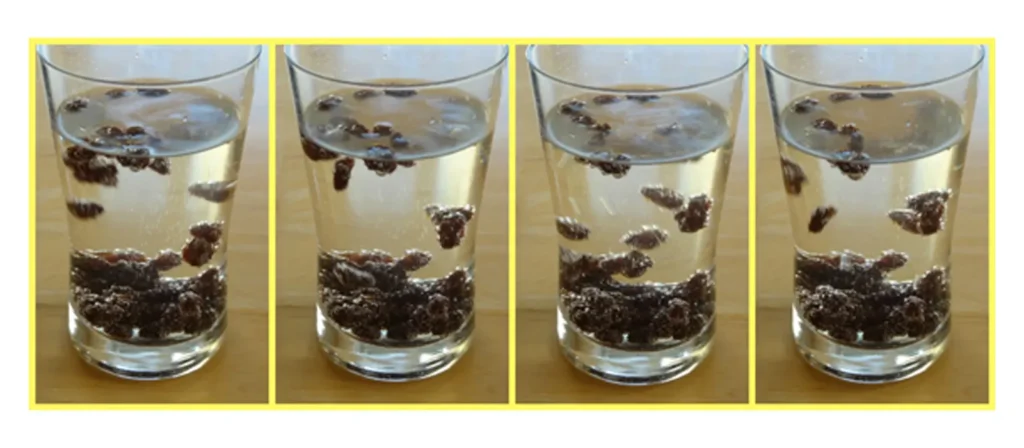
Materials: Raisins, soda water, clear cup.
Drop raisins into a cup of soda water and watch them “dance” as the carbonation bubbles attach to the raisins, making them rise. When the bubbles pop, the raisins sink again. This fun science activity for preschoolers teaches about buoyancy and how gases can lift objects in the water.
29. Rubber Egg Experiment
Materials: Egg, vinegar, clear cup.
Place an egg in a cup of vinegar and leave it for two days. The vinegar will dissolve the eggshell, leaving behind the rubbery membrane. This indoor science activity for preschoolers teaches about acids and how they can break down calcium, showing children a fascinating chemical reaction.
30. Static Butterfly
Materials: Tissue paper, balloon, scissors, tape.
Cut out a butterfly shape from tissue paper, tape it to a table, and use a balloon rubbed on your head to create static electricity. When you bring the balloon close to the butterfly, its wings will flap. This science sensory activity for preschoolers is a simple and fun way to introduce children to static electricity.
31. Water Cycle in a Bag

Materials: Ziplock bag, water, marker, tape.
Draw a simple water cycle diagram on a Ziplock bag, fill it with a small amount of water, and tape it to a sunny window. Over time, the water evaporates and condenses, simulating the water cycle. This summer science activity for preschoolers teaches about evaporation, condensation, and precipitation.
32. Shaving Cream Rain Clouds
Materials: Clear glass, water, shaving cream, food coloring.
Fill a glass with water and top it with shaving cream. Drop food coloring onto the shaving cream, and watch it “rain” as the color passes through it and into the water. This science center activity for preschoolers is a simple and effective way to teach them about clouds and precipitation.
33. Blubber Glove
Materials: Shortening (like Crisco), two plastic bags, ice water, and tape.
Fill one plastic bag with a shortening and place another inside it. Have the children put their hand inside the “blubber glove” and dip it into ice water. This winter science activity for preschoolers shows how animals like polar bears are insulated from the cold by their layers of fat, teaching children about insulation and animal adaptations.
34. Earthquake Jello
Materials: Jello, building blocks.
Prepare Jello and let it set. Then, small block buildings are placed on top, and the dish is shaken to simulate an earthquake. Children will observe how the “earthquake” affects the buildings, introducing them to structural engineering concepts and how buildings react during an earthquake. This is a great fall science activity for preschoolers as part of a lesson on natural disasters.
35. Oobleck Experiment
Materials: Cornstarch, water, bowl, food coloring (optional).
Mix cornstarch with water to create Oobleck, a non-Newtonian fluid that behaves as both a solid and a liquid. When squeezed, it feels solid but flows like a liquid when released. This science and sensory activity for preschoolers teaches about viscosity and helps preschoolers understand the differences between solids and liquids in a hands-on way.
More Related Questions
- What makes a good science activity for preschoolers?
A good science activity for preschoolers is age-appropriate, safe, interactive, and fun, stimulating curiosity and encouraging exploration. - How can science activities for preschoolers improve children’s cognitive skills?
Science activities help improve preschoolers’ cognitive skills by developing observation skills, enhancing problem-solving abilities, and fostering logical thinking. - What are the safety considerations when conducting science activities for preschool?
Safety considerations include using non-toxic and age-appropriate materials, supervising closely to prevent ingestion of small parts, and ensuring the physical setup is safe for active, young children. - How can parents get involved in their child’s science learning activities for preschoolers?
Parents can get involved by participating in activities, providing resources, asking guiding questions, and expressing enthusiasm for exploring science topics. - Can science activities for preschool help with emotional development?
Science activities can support emotional development by helping children learn to manage failures and frustrations, boost their confidence, and enhance their communication skills. - What are some outdoor science activities for preschoolers that can engage young children?
Outdoor science activities that engage preschoolers include exploring nature, collecting leaves for classification, observing weather changes, and doing simple water experiments.
Conclusion
Introducing science activities for preschoolers through fun, engaging experiments helps nurture curiosity, critical thinking, and a love for learning. By carefully preparing each experiment and choosing age-appropriate materials, you can offer exciting opportunities for discovery in your classroom. Let these science learning activities for preschoolers inspire the young scientists in your class!

